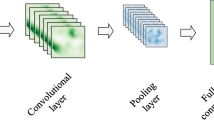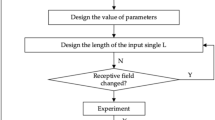Abstract
Affected by the transmission path, it is very difficult to diagnose the vibration signal of the rolling bearing on the aircraft engine casing. A fault diagnosis method based on convolutional neural network is proposed for the weak vibration signal of the casing under the excitation of rolling bearing fault. Firstly, the processing method of vibration signal is studied. Through comparison and analysis, it is found that the fault characteristics of rolling bearing are more easily expressed by continuous wavelet scale spectrum, and a better recognition rate is obtained. Finally, the experiment was carried out with an aero-engine rotor tester with a casing, and the method based on wavelet scale spectrum and convolutional neural network was used for diagnosis. The results were compared with the support vector machine method. The results show that the method has a high recognition rate for the weak fault signals of different fault types collected on the aero engine case, and its fault recognition rate reaches 95.82 %, which verifies the superiority and potential of the method for rolling bearing fault diagnosis.
Similar content being viewed by others
References
H. B. Mei, Vibration Monitoring and Diagnosis of Rolling Bearings, Mechanical Industry Press (1995).
R. B. Randall and J. Antoni, Rolling element bearing diagnostics - A tutorial, Mechanical Systems and Signal Processing, 25 (2) (2011) 485–520.
Z. Q. Chen, X. Li and R. V. Sanchez, Gearbox fault identification and classification with convolutional neural networks, Shock and Vibration, 2 (2015) 1–10.
Q. D. Zhang et al., State evaluation method of rolling bearing based on self-organizing neural network, China Mechanical Engineering, 5 (2017).
G. Chen, Feature extraction and intelligent diagnosis of early faults in rolling bearings, Acta Aeronautica Sinica, 30 (2) (2009) 362–367.
L. Saidi, X. J. Ben and F. Fnaiech, Application of higher order spectral features and support vector machines for bearing faults classification, ISA Transactions, 54 (2015) 193–206.
R. Socher, X. Huval, X. P. Bath, X. D. Manning and A. Y. Ng, Convolutional-recursive deep learning for 3D object classification, NIPS, 3 (7) (2012) 8.
Y. LeCun, X. Bengio and G. Hinton, Deep learning, Nature, 521 (7553) (2015) 436–444.
R. X. Chen et al., Diagnosis of rolling bearing damage degree by stack sparse noise-added self-coded deep neural network, Journal of Vibration and Shock, 36 (21) (2017) 132–138, 144.
Y. G. Lei et al., The big data health monitoring method for mechanical equipment based on deep learning theory, Journal of Mechanical Engineering, 51 (21) (2015) 49–56.
H. D. Shao et al., Rolling bearing fault feature learning using improved convolutional deep belief network with compressed sensing, Mechanical Systems and Signal Processing, 100 (2018) 743–765.
X. Zeng, X. Liao and W. Li, Gearbox fault classification using S-transform and convolutional neural network, International Conference on Sensing Technology (2016).
H. Li et al., Fault diagnosis method for rolling bearings based on short-time Fourier transform and convolution neural network, Journal of Vibration and Shock, 37 (19) (2018) 124–131.
O. Janssens et al., Convolutional neural network based fault detection for rotating machinery, Journal of Sound and Vibration, 377 (2016) 331–345.
C. Z. Wu et al., Gearbox fault diagnosis based on one-dimensional convolutional neural network, Journal of Vibration and Shock, 37 (22) (2018) 56–61.
W. Zhang et al., A deep convolutional neural network with new training methods for bearing fault diagnosis under noisy environment and different working load, Mechanical Systems and Signal Processing, 100 (2018) 439–453.
J. Feng et al., Deep normalized convolutional neural network for imbalanced fault classification of machinery and its understanding via visualization, Mechanical Systems and Signal Processing, 110 (2018) 349–367.
X. Guo, X. Chen and C. Shen, Hierarchical adaptive deep convolution neural network and its application to bearing fault diagnosis, Measurement, 93 (2016) 490–502.
A. Krizhevsky, X. Sutskever and G. Hinton, ImageNet classification with deep convolutional neural networks, NIPS (2012).
L. C. Yang et al., Gradient-based learning applied to document recognition, Proceedings of the IEEE, 86 (11) (1998) 2278–2324.
G. Chen et al., Sensitivity analysis and experimental research on ball bearing early fault diagnosis based on testing signal from casing, Journal of Dynamic Systems, Measurement, and Control, 136 (6) (2014) 061009–061019.
J. Antoni, Fast computation of the kurtogram for the detection of transient faults, Mechanical Systems and Signal Processing, 21 (1) (2007) 108–124.
S. J. Cheng et al., Application of scale-wavelet energy spectrum in fault diagnosis of rolling bearings, Journal of Vibration Engineering, 17 (1) (2004) 82–85.
Acknowledgments
This research is sponsored by the National Natural Science Foundation of China (No. 51675263), and National Science and Technology Major Project (2017-IV-0008-0045).
Author information
Authors and Affiliations
Corresponding author
Additional information
Recommended by Editor Chongdu Cho
X. Y. Zhang is a Master’s student at the College of Civil Aviation, Nanjing University of Aeronautics and Astronautics, Nanjing, China. His current research interests include deep learning and pattern recognition, and their applications in bearing fault diagnosis.
G. Chen received a Ph.D. degree in the School of Mechanical Engineering from the Southwest Jiaotong University, Chengdu, P. R. China, in 2000. Now he works at the College of Civil Aviation, Nanjing University of Aeronautics and Astronautics, Nanjing, P. R. China. His current research interests include the whole aero-engine vibration, rotor-bearing dynamics, rotating-machine fault diagnosis, pattern recognition and machine learning, signal analysis and processing.
Rights and permissions
About this article
Cite this article
Zhang, X., Chen, G., Hao, T. et al. Rolling bearing fault convolutional neural network diagnosis method based on casing signal. J Mech Sci Technol 34, 2307–2316 (2020). https://doi.org/10.1007/s12206-020-0506-8
Received:
Revised:
Accepted:
Published:
Issue Date:
DOI: https://doi.org/10.1007/s12206-020-0506-8




